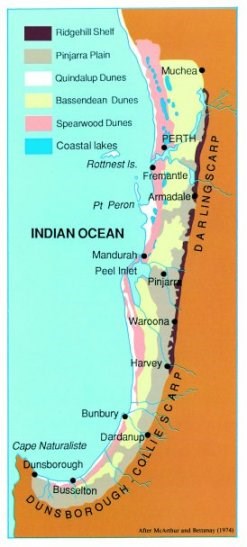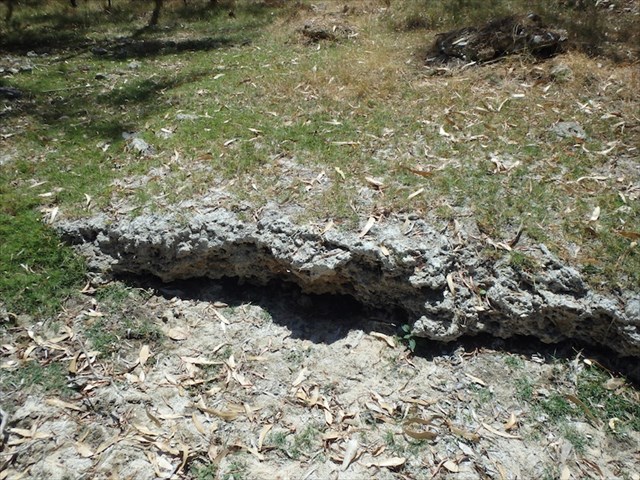The near-coastal parts of the Swan Coastal Plain comprise three phases of sand dunes that are recognized geomorphologically, progressing easterly from the coast as:
Quindalup Dunes:these contain the modern, nearshore, unconsolidated dunes consisting of quartz and limesand
Spearwood Dunes:are slightly older, consist of quartz and limestone and is where the limesand is cemented to form limestone (Tamala Formation)
Bassendean Dunes:the most inland dunes; lower, highly degraded and well rounded; consist mostly of white quartz sand from which the lime component is interpreted to have been dissolved.

The most extensive deposits of aeolianite in the world are located on the southern and western coasts of Australia. Tamala Formation is the geological name given to the widely occurring calcareous aeolianite limestone deposits on the coastline of Western Australia.
There are over 800 kilometres of aeolianite cliffs which are over 150 metres thick in some places. These cliffs contain layers of dune origin interspersed with layers of shallow-marine origin. They run between Shark Bay in the north and nearly to Albany in the south.

This area of Tuart Forest is part of the Tamala Formation in the Spearwood Dune phase. The soils found here near the Vasse and Wonnerup Inlets are formed from estuarine alluvia and are at about sea level. They are extremely variable soils, comprising layers of clay, shells, marine algae and coarse calcareous sand. Many of these deposits were formed during the past two million years of geological history.
The rock consists of calcarenite wind-blown shell fragments and quartz sand which accumulated as coastal sand dunes during the middle and late Pleistocene and early Holocene eras. As a result of a process of sedimentation and water percolating through the shelly sands, the mixture later lithified when the lime content dissolved to cement the grains together.
Limesand (or shell sand) is the term used for sands rich in calcium carbonate, commonly from fragments of marine shells. Here on the western margin of the Spearwood dunes the shell fragments are mostly calcium carbonate, so the sands are alkaline.
Several thousand years of weathering has leached the shell fragments and calcareous cement from some of the limestone. As the shell fragments dissolve, calcium percolates downward and is deposited as lime. Eventually, the lime is deposited as limestone at the bottom of the profile of the dunes.
The surface deposits of limesand and limestone attracted early settlers. The lime kilns, at the northern end of this Tuart Forest, were built in the mid-late 1800s and are now partially dilapidated.
Currently, the main source of lime for cement and lime product manufacture is dredged limesand. Limesand also has an important role in neutralising soil acidity as fertiliser in agriculture. A more recent demand for lime has been for the remineralisation of desalinated water. Limestone is currently extracted at Capel and Myalup. Agricultural lime is also currently distributed from a range of sites in the coastal dunes around Preston Beach.
Remember to take only photos and leave no trace of your visit. We hope you enjoy your visit to this geologically interesting area of 'our own backyard' in Western Australia's southwest.
In order to get your smiley you may log this Earthcache straight away but then please email your answers to the questions to the CO. We will contact you ONLY if your answers need extra work. Logs with no answers sent will be deleted. Please do not post your answers in your log.
Q1. In geological terms, what are aeolian deposits?
Q2. In geological terms, what does lithification mean?
Q3. Take a stroll around and look carefully. In the vicinity of GZ describe some of the evidence you can see that this is part of the original Spearwood dunes system.